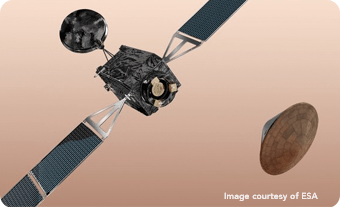ExoMars embarks on its journey to Mars

On 14 March, right on schedule, the first ExoMars mission successfully blasted off from Kazakhstan's Baikonur Cosmodrome onboard a Proton-M rocket operated by the Russian Space Agency Roscosmos.
The dual-mission ExoMars program has been developed by ESA with the aim of investigating the Martian environment and trial new technologies paving the way for a future Mars sample-return mission in the 2020s.
This first mission just launched includes a Trace Gas Orbiter (TGO) and an entry, descent and landing demonstrator module (EDM). The orbiter carries scientific instruments to look for and study trace gases of the atmosphere, including methane. The EDM contains sensors to evaluate the landing module during the descent plus additional sensors to study the surroundings in the landing area.
In this first mission GMV’s participation includes development of the onboard software of the guidance, navigation and control (GNC) system of Exomars’s entry and descent module (EDM. The software will automatically trigger all Entry Descending and Landing (EDL) phases including controlled entry into the Martian atmosphere, parachute deployment and use of thrusters for the landing, all to ensure a safe touchdown. GMV has also developed the GNC On-Board Software (OBSW) code, carried out the unit testing and participated actively in system validation on Thales Alenia Space’s Italian site
Furthermore, as part of the activities carried out within the framework contract of support for ESA’s European Space Operations Centre (ESOC), GMV still holds responsibility for the Flight Dynamics Manager and will also participate actively in the mission’s orbital control.
The second part of the ExoMars mission, scheduled for 2018, will include a rover carrying a drill and a suite of instruments for exobiology and geochemistry research. On this occasion GMV will participate in development of the complete mission application software of the guidance, navigation and control (GNC) system and also other subsystems (thermal system, remote-command system, guidance and control of the carrier module as well as the descent module, power system). It will also develop the Software Verification Facility (SVF) used for validation of the Application SW. It will input the onboard computer simulator (OBC1) and will take on responsibility for development of the ROVER control center, to be run from its site in Turin, Italy, using the data management and control system designed and developed by GMV. It will also supply the CM-DM (Central Checkout System).